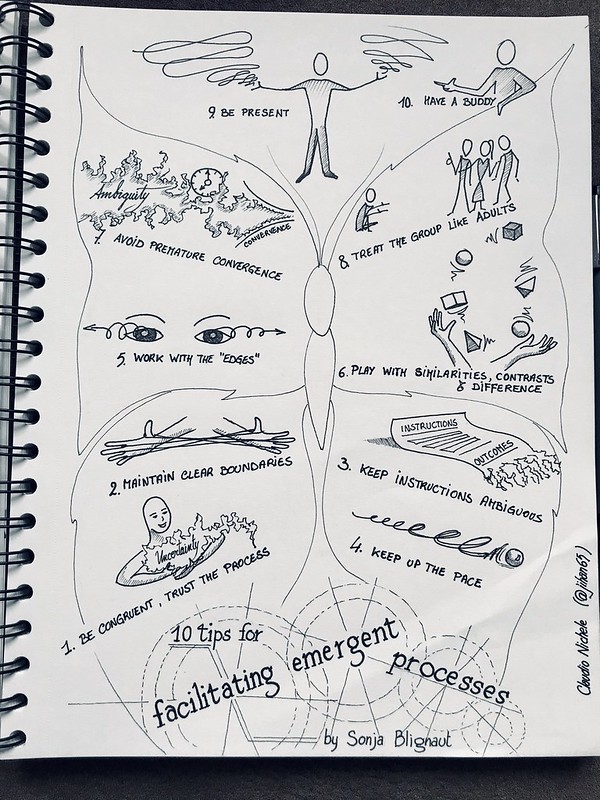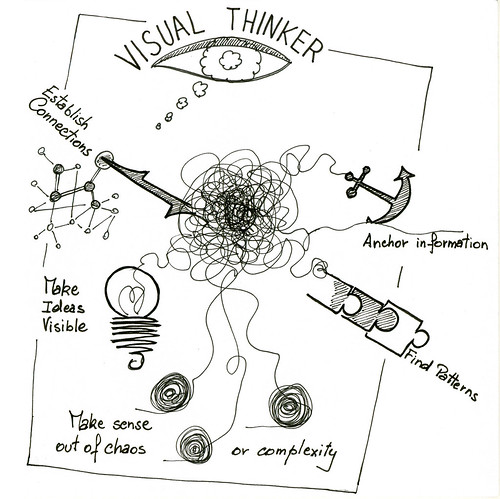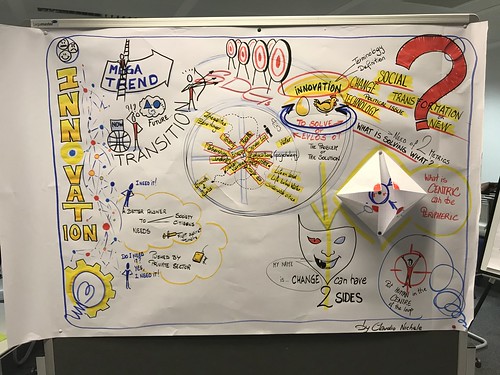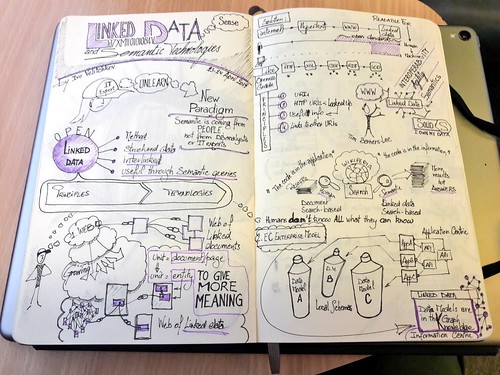Que vous inspire le nombre 12?
Les douze coups de minuit? Peut-être un nombre sublime en mathématiques? (peut-être pas, désolé, j’aime bien les maths). Peut-être pensez-vous au nombre de signes du zodiaque, d’étoiles sur le drapeau Européen, de disciples de Jesus, de syllabes pour un alexandrin, de côtes dans votre corps, de travaux d’Hercules? Laissez courir votre pensée autour de ce nombre. Divaguez dans les mythes et les religions où il revient souvent.
Douze, c’est aussi et plus simplement, le nombre de mois dans une année. Eh ben, me direz-vous, toute cette diversion pour en arriver à cette banalité? Oui, car j’avais besoin que votre imagination s’évade en pensant au nombre douze, afin de mieux comprendre ce qui suit.
Ca fait un an, donc douze mois, que j’ai accepté de collaborer au blog toutestpossible.be de mon amie Florence Bierlaire en illustrant ses billets mensuels. Chaque mois, Florence m’envoit le texte de son prochain billet et elle me laisse carte blanche pour l’illustrer.
La confiance aveugle de Florence me rempli d’une joie immense car elle est le signe d’un respect, d’une reconnaissance et d’une grande amitié entre nous deux. Cette relation privilégiée fertilise le terrain où mon inspiration et ma créativité peuvent s’exprimer librement.
Liberté, certes, mais comme toute liberté il faut l’assumer. C’est pour moi un défi chaque mois. J’ai le trac quand je reçois l’email de Florence qui contient le texte de son nouveau billet à illustrer. De quel sujet s’agit-il? Vais-je en comprendre le sens? Serais-je inspiré pour l’illustrer? Trouverais-je un language visuel que les lecteurs de Florence comprendrons? Qui soit respectueux du sujet, de Florence la psy, de Florence mon amie et surtout de ses lecteurs? Autant de questions, et d’autres encore, qui reviennent chaque mois.
Mes inquiétudes laissent toutefois rapidement place à l’appétit et à l’excitation.
J’entre alors dans le texte, un nouvel espace à découvrir, un autre renard à apprivoiser, une nouvelle semence à planter. Mon procédé est pratiquement toujours le même: lire le texte, comprendre, relire, ne pas interpréter, rester dans ce qui est dit, digérer, attendre, laisser reposer, relire ça et là le texte, le butiner, garder en mémoire ou esquisser mes idées visuelles, surtout les premières qui s’avèreront souvent être les meilleures, surligner dans le texte les mots ou les phrases qui me marquent, croquer au crayon les liens mentaux entre ces idées fortes. Puis, faire le point lentement. Décanter. Méditer sur les mots, les idées, les visuels, les connexions, les couleurs, mes émotions, mes ressentis.
A la fin vient mon carnet de dessin où j’y agence mes idées en traits de crayon d’abord, en courbes, en couleurs et en ombres ensuite. Parfois simplement en noir et blanc.
Voici les 12 illustrations de l’année 2017. Vous pouvez cliquer les images pour les agrandir et le lien en dessous pour lire l’article dans son entièreté:
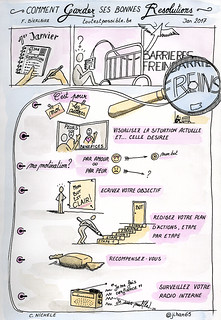
Janvier 2017: Comment instaurer de nouvelles habitudes dans votre vie?

Février 2017: Comment avoir plus de jus au quotidien et déborder d’énergie?
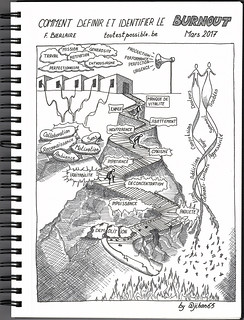
Mars 2017: Le burn out: Comment définir et identifier ce mal qui nous consume?
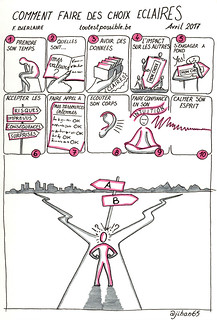
Avril 2017: Comment faire des choix éclairés en 10 étapes?
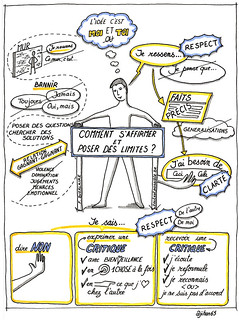
Mai 2017: J’apprends à m’affirmer et à poser mes limites
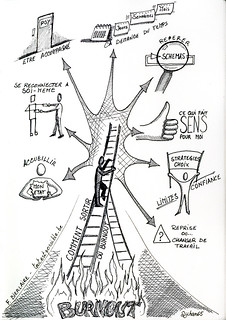
Juin 2017: Le burn out: Comment en sortir, comment se reconstruire ?

Juillet 2017: Retrouver l’art de flâner et adopter la slow attitude!
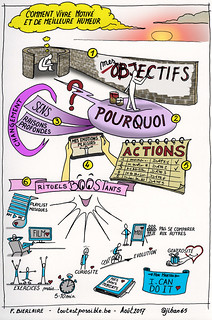
Août 2017: Comment vivre motivé et de meilleure humeur !

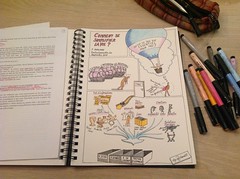
Septembre 2017: Apprendre à se simplifier la vie !

Octobre 2017: Comment réveiller le charisme naturel qui est en vous ?
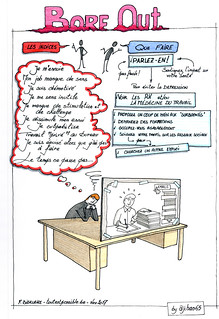
Novembre 2017: Le Bore Out ! Un phénomène aussi destructeur que le Burn Out?
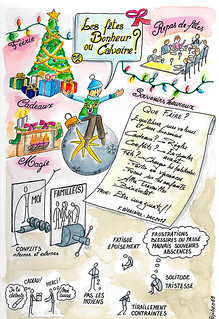
Décembre 2017: Les Fêtes de fin d’année : bonheur pour les uns, calvaire pour les autres !
Illustrer les billets de Florence qui traitent de psychologie ne fut pas chose aisée, même si l’humain et ses relations avec les autres et avec lui-même sont un domaine que j’apprécie particulièrement. Je constate, outre l’aspect purement technique du dessin, que cela m’a demandé de la concentration pour bien comprendre ce qui est dit, et juste ce qui est dit, sans extrapoler. Une juste balance entre la méditation nécessaire pour digérer le sujet et … laisser courir mon imagination autour de ce dernier. C’est cet équilibre qui aura représenté la plus grande difficulté. M’en tenir au sujet mais imaginer loin comment le visualiser.
Les douzes articles de 2017 auront été un défi où, à chaque mois, j’aurais appris quelque chose. Ce fut avant tout une très belle expérience humaine entre Florence et moi. Je suis sûr qu’elle va grandir encore lors de cette nouvelle année (retrouvez les nouvelles illustrations dans mon album Flickr). Cette collaboration m’a aussi et surtout aidé à progresser dans ma pratique de l’illustration, dans celle de la lecture attentive ainsi que dans mes autres activités où j’utilise le language visuel.
Merci Florence!
